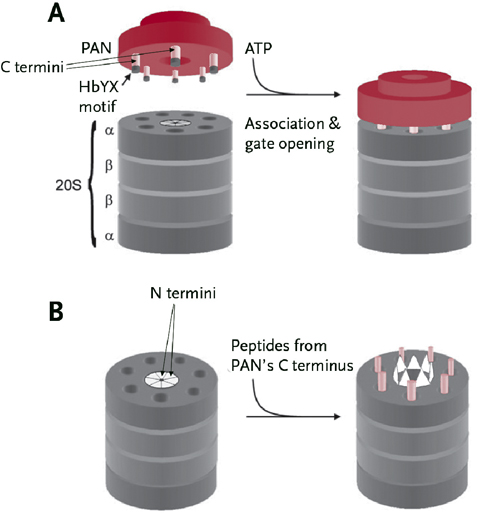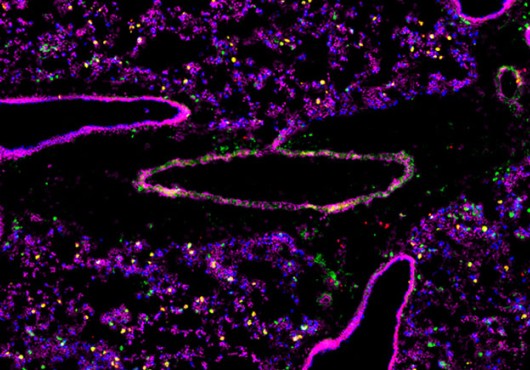The lock and key metaphor for a precise molecular fit has been around for decades. Though widely used to describe how a substrate fits into the active site of an enzyme, the biology rarely lives up to the analogy: in enzymes, there are no doors, no locks, and no keys to open them. But at least one true lock and key combination does exist in nature. In the Sept. 7 Molecular Cell, HMS researchers led by professor of cell biology Alfred Goldberg reveal how a precise molecular fit is needed to pop the hatch on the barrel-shaped core proteasome complex. The finding uncovers a crucial step in the degradation of unwanted proteins and may open the door to novel medicines. The work also helps resolve a long-standing biochemical mystery—why ATP is needed for protein degradation in the cell.
The energy requirement has puzzled scientists because no typical protease, including those in the core proteasome, needs ATP for activity. Work from Goldberg’s and other labs, however, had shown that the large 19S ATPase complex, which sits atop the core proteasome, consumes energy when ubiquitinated proteins are degraded. This knowledge has led to the suggestion that the ATPase functions as a key that opens a gate into the proteasome interior.
The idea fits with proteasome architecture. The core 20S proteasome is a hollow cylinder comprising four donut-shaped protein complexes stacked one on top of the other. Proteins must pass through the outer rings into the center of the proteasome before they can be degraded. Yet the seven subunits that compose the outer rings can seal the proteasome shut with their N termini. Prior work by David Smith, a postdoctoral fellow in Goldberg’s lab, had shown that when the ATPase binds ATP, it somehow forces the N termini apart, opening the proteasome door to proteins targeted for destruction.
Cracking the GateTo understand this gate-keeping process, Smith and colleagues began studying how the ATPase and the N termini of the outer-ring proteins interact. Smith found that the C termini of the ATPase subunits are crucial, because after removing these amino acids by carboxypeptidase treatment or mutation, the proteasome remained closed to a small nine-residue peptide commonly used to measure proteasome activity. Focusing on the C termini, Smith and colleagues then compared sequences of the six subunits that make up the eukaryotic 19S ATPase (Rpt1 through Rpt6) with those from the homologous ATPase complex, PAN, which controls proteasome function in archaebacteria. They found that a small, three-residue motif, HbYX (where Hb is any hydrophobic amino acid, Y is tyrosine, and X an acidic residue) is common to all subunits and that mutating the hydrophobic residue or the tyrosine was sufficient to prevent the proteasome door from opening.
But is the HbYX motif the key that opens the proteasome door, or is it merely essential for docking the ATPase to the proteasome? One central experiment was to insert a fluorescent amino acid into PAN’s C terminus and then use a biophysical approach to show that it is quenched when the ATPase binds to the proteasome. “That shows that when the ATPase associates with the proteasome, its C terminus is docking into a new environment,” said Goldberg. But that would not necessarily preclude the involvement of other residues, he explained. The definitive answer was to try the C terminal sequence by itself—after removing it from the 19S ATPase ring. With this approach, Smith found that a small, seven–amino-acid peptide was sufficient to open the door into the archaebacterial proteasome. “With the big protein you can go so far, but the small peptides really proved that you need no other domains, that they work like a key in a lock,” said Goldberg. The final critical piece of evidence was showing, by mutation, that these C termini dock into specific pockets in the outer ring of the core proteasome when they cause gate opening.
More Hacking NeededGoldberg said that these small peptides are fantastic tools to study how the proteasome opens and closes, which is fortunate because the lock and key turns out to be more complex in eukaryotic proteasomes. There are different keys on each of the six subunits of the eukaryotic 19S ATPase, for example, and seven different pockets between each of the alpha subunits in the outer ring of the proteasome core (see figure).

So which combination is required to open the gate? Smith and Goldberg have addressed this question together with postdoctoral fellow Soyeon Park and HMS professor of cell biology Daniel Finley. By individually mutating the six C termini of the yeast 19S ATPase, they found that only some of the keys are needed for gate opening, while some of the other C termini are needed to stabilize the interaction between the ATPase complex and the core proteasome. That finding fits with peptide experiments, which showed that only the C terminal peptides from the Rpt2 and Rpt5 ATPases could independently open the proteasome. “What this is telling us is that although the key-in-a-lock mechanism controls gate opening in the mammalian proteasome, now, in 2007, we still don’t understand the specialized roles of the different ATPase subunits,” said Goldberg.
Despite this gap, the proteasome is still a prime therapeutic target. Proteasome inhibitors that target the core proteolytic enzymes have already been developed by Goldberg and collaborators and are widely used as research tools—one is now being used to treat multiple myeloma in the form of bortezomib (Velcade). But there is also intense interest in the role of the proteasome in neurodegenerative diseases because of their association with accumulations of undegraded proteins inside neurons. “At the moment there is no rational method for activating the proteasome, but we now think we have identified a way to open the gate that usually keeps substrates out,” said Goldberg. This could accelerate the breakdown of unfolded proteins. “Whether or not enhancing protein breakdown will be useful rests on the biology and our ability to identify drugs that trigger gate-opening,” he said.


